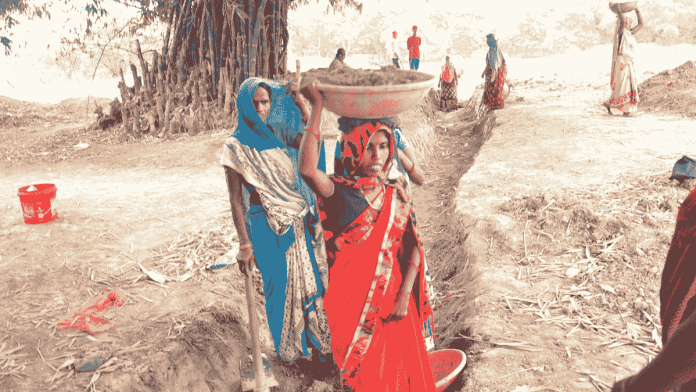New Delhi: The Union Ministry of Rural Development plans to introduce technology for three-dimensional land profiling of work sites while preparing the estimates to bring in transparency and better monitoring of projects under the Mahatma Gandhi National Rural Guarantee Scheme (MGNREGS), ThePrint has learnt.
“The idea is to make estimate preparation more accurate and also address issues related to monitoring the work progress. Currently, all the information regarding the projects — from estimate preparation to assessment of work that is being done — is carried out by the engineers. The estimates are prepared manually and often are not very accurate. Use of technology will help in almost accurate preparation of estimates and also help in proper evaluation of work,” an official of the ministry told ThePrint.
The ministry has held several rounds of discussions with private companies, technical institutions such as Indian Institutes of Technology (IITs), Indian Institutes of Information Technology (IIITs) and others in this regard, said rural development officials.
“The discussion is in the nascent stage with these institutions. We are looking for cheapest options as our projects are not very big. We are exploring all options such as use of drones or satellite images or ground-based assessment using mobile devices etc. Use of technology will also make monitoring of the projects much easier and increase efficiency,” another official said.
While states have a monitoring mechanism to assess the work done, officials said, a need was felt to upgrade the existing system to have more accurate estimates and clarity about the volume of work.
Launched in 2006 as a social safety net programme, MGNREGS guarantees at least 100 days of paid work to rural families across the country. It has become one the largest public works programmes in the world.
In the past few years, close to 70-90 lakh projects were completed annually under the MGNRGES, according to a report of the Standing Committee on Rural Development and Panchayati Raj tabled in Parliament in March.
In 2022-23, 78 lakh projects were completed till February this year and 89.69 lakh projects were completed in 2021-22, the report said.
Also Read: MGNREGS hits record with 3.1 crore families seeking work in May. It’s a cry for help from Bharat
3D technology for land profiling
The ministry is exploring the possibility of carrying out a 3D land profile of the work site or digital elevation modeling that can help in assessing the volume of earth work (as digging has to be done at most work sites) involved, the terrain and other factors.
Government agencies such as the National Highways Authority of India (NHAI) use 3D-terrain modeling while preparing estimates and planning for capital intensive projects.
“Our projects are not very big. It mostly involves construction of water bodies, sheds, plantations etc. The technology used by agencies such as NHAI is expensive as the projects are capital intensive. We are looking for cheap options so that just 2-4 percent of the project cost is spent on preparation of work estimates,” said the second official quoted above.
Other technology initiatives
In January, the ministry made the use of the National Mobile Monitoring System (NMMS) — introduced in 2021 — mandatory for capturing attendance of MGNREGS workers. It also pushed for making Aadhaar-Based Payment System (ABPS) mandatory for payment of wages to workers.
According to media reports, both the decisions were opposed by workers and activists citing issues related to poor network connectivity in rural areas, the burden on labourers to get their Aadhaar linked to the bank accounts, etc.
“To ensure more transparency in the implementation of Mahatma Gandhi National Rural Employment Guarantee Scheme, a provision for capturing of attendance at worksite through NMMS app with geo-tagged time stamped photographs of the worker in a day has been started on 21st May 2021, wherein muster rolls were issued for 20 or more workers. This increases citizen oversight of the programme besides potentially enabling faster processing of payments,” the ministry said in a statement in March.
As for ABPS, in an order dated 30 January, 2023, the government made it compulsory that all MGNREGS payments were to be done through the system from 1 February.
However, following protest by workers and on requests received from state governments, the deadline was extended first to 1 April and then 1 July, according to media reports. The ministry recently extended the deadline till 31 August as many states are yet to complete the process.
(Edited by Anumeha Saxena)
Also Read: Ex-finance secy writes to Modi govt, red-flags ‘gaps’ in last-mile delivery of welfare schemes






